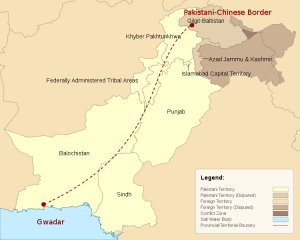Understanding the China-Pakistan Economic Corridor
By Dezan Shira & Associates
 The China-Pakistan Economic Corridor (CPEC) is a key component of China’s OBOR ambitions, and also closer to home – the two countries share a common border. It is important when studying the economic dynamics of the New Silk Road to understand that China has more than trade as a motivating factor. Beijing is concerned about Muslim fundamentalism spreading across its borders, and is wary of anything upsetting an already fragile Xinjiang Province. ISIS have already threatened China with terrorist acts, and keeping this at bay is a priority. Unlike the United States, Chinese nationals are not used to the sight of their soldiers returning home in body bags. Part of China’s OBOR policy, therefore, is to promote peace via trade, or in the words of Chinese Premier Li Keqiang, as a means to ‘wean the populace from fundamentalism’.
The China-Pakistan Economic Corridor (CPEC) is a key component of China’s OBOR ambitions, and also closer to home – the two countries share a common border. It is important when studying the economic dynamics of the New Silk Road to understand that China has more than trade as a motivating factor. Beijing is concerned about Muslim fundamentalism spreading across its borders, and is wary of anything upsetting an already fragile Xinjiang Province. ISIS have already threatened China with terrorist acts, and keeping this at bay is a priority. Unlike the United States, Chinese nationals are not used to the sight of their soldiers returning home in body bags. Part of China’s OBOR policy, therefore, is to promote peace via trade, or in the words of Chinese Premier Li Keqiang, as a means to ‘wean the populace from fundamentalism’.
To date, trade between China and Pakistan has been conducted largely across the Friendship Highway – the Karakoram route, which extends via road from Gilgit, across the border at Taxkorgan, and through to Kashgar, meeting up with China’s rail network.
RELATED: Kashgar to Become Central Asian Trading Hub, Again
Expanding infrastructure, however, is difficult. The terrain here is volatile and mountainous, with extreme weather conditions. Chinese engineering, which after all built a railway to Lhasa, should be able to cope with the challenges. Nevertheless, India will object as China is proposing to build infrastructure on territory that India claims, and this will not sit well in Delhi. Additionally, the area is highly tribal. Local warlords make the rules here and arms are easily purchased at local shops. This is especially not an area that welcomes newcomers, and that will include Chinese work forces who will inevitably be employed to build the structures required. A large measure of seduction, cajoling, and detente, let alone diplomacy will be needed to get the CPEC operational.
The development of the CPEC is expected to cost some US$54 billion. It will upgrade Pakistan’s infrastructure – especially its road and rail system, and introduce pipelines. The development is also part of Pakistan’s Vision 2025 meaning both Beijing and Islamabad are essentially on the same page as to making it happen.
From an economic point of view, the CPEC involves strengthening the Pakistani economy through infrastructure projects, establishing Special Economic Zones (SEZs), improving electricity supply and redressing Pakistan’s energy shortages. This is identical to the process that China went through in the late 1980s until mid-1990s. The construction of the world’s largest solar energy plant in Pakistan, deemed an OBOR project, and financed by the Asian Infrastructure Investment Bank (AIIB), is indicative of the OBOR priority given to Pakistan’s decrepit energy sector. In fact, if all the CPEC projects come to pass, the combined value will surpass all foreign direct investment in Pakistan since 1970, and be the equivalent of 17 percent of Pakistan’s total GDP.
RELATED: Wen Moves China Closer To Pakistan with USD35 Billion Deal
A lot here depends on Delhi. The country still bears scars of the 2008 Mumbai attacks, and China will need to do a great deal to reverse the process of “keeping India occupied” via encouraging Pakistani mischief on India’s northwestern border over the past few decades. Still, some in Delhi now feel having an economically stronger Pakistan may help solve problems, essentially aligning themselves with Li Keqiangs’ remarks. China also needs India today rather more than it needs Pakistan, and India’s reluctance to be open armed is a direct result of previous Chinese antagonistic policy.
Meanwhile, CPEC development goes on, although crucially not yet anywhere near the corridors that would directly link Pakistan and China through the Northern areas. However, it is a sign of some pragmatism that both India and Pakistan have been accepted as full members of the Shanghai Co-Operation Organization. How this will play out in bringing these arch enemies back together, at least in terms of agreeing to infrastructure development on disputed territory, will require a huge diplomatic effort from China. It will be some time yet before rail services run from Kashgar to Gilgit.
An excellent and informative National Geographic film “The Pakistan China Economic Corridor” can be found on You Tube here.
About Us
Silk Road Briefing is published by Asia Briefing, a subsidiary of Dezan Shira & Associates. We produce material for foreign investors throughout Eurasia, including ASEAN, China, India, Indonesia, Russia & Vietnam. For editorial matters please contact us here and for a complimentary subscription to our products, please click here.
Dezan Shira & Associates provide business intelligence, due diligence, legal, tax and advisory services throughout the Asian and Eurasian region. We maintain offices throughout China, South-East Asia, India and Russia. For assistance with OBOR issues or investments into any of the featured countries, please contact us at silkroad@dezshira.com or visit us at www.dezshira.com
Related Reading:
Silk Road and OBOR Business Intelligence
Dezan Shira & Associates´ Silk Road and OBOR investment brochure offers an introduction to the region and an overview of the services provided by the firm. It is Dezan Shira´s mission to guide investors through the Silk Road´s complex regulatory environment and assist with all aspects of establishing, maintaining and growing business operations in the region.
China’s New Economic Silk Road
This unique and currently only available study into the proposed Silk Road Economic Belt examines the institutional, financial and infrastructure projects that are currently underway and in the planning stage across the entire region. Covering over 60 countries, this book explores the regional reforms, potential problems, opportunities and longer term impact that the Silk Road will have upon Asia, Africa, the Middle East, Europe and the United States.
 







